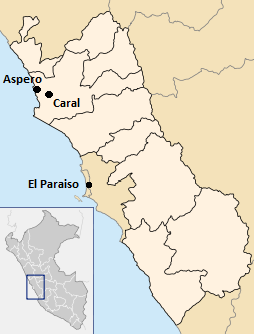El Paraíso, Peru
 |
|
| Location | San Martin de Porres, Chillon River Valley, |
|---|---|
| Region | Chillon River Valley |
| Coordinates | 11°57′13.68″S 77°7′6.39″W / 11.9538000°S 77.1184417°W |
| History | |
| Founded | 3790 cal. B.P. |
| Abandoned | 3065 cal B.P. |
| Periods | Cotton Preceramic |
| Site notes | |
| Excavation dates | 1960s, Frédérick Engel; 1980s Jeffrey Quilter |
| Archaeologists |
Jeffrey Quilter, Ripon College, Wisconsin ? |
| Architecture | |
| Architectural details | Number of monuments: 10 |
| Responsible body: Ministry of Culture, Peru | |
Coordinates: 11°57′14″S 77°7′6″W / 11.95389°S 77.11833°W
Jeffrey Quilter, Ripon College, Wisconsin
El Paraíso (IPA: /el pa.raˈi.so/, "ell pah-rah-EE-so") is the modern name of a Late Preceramic (3500-1800 BC) archaeological site located in the Chillón Valley on the central coast of Peru. The site is situated several kilometers north of Lima, the capital of Peru, in the San Martin de Porres District in the Province of Lima. El Paraíso is one of the largest settlements from this period, encompassing over 58 hectares of land.
Other major centers from this period include Aspero and Caral on the northern coast in the Supé Valley. Sizable centers can be found in different ecozones, from the coast to inland areas. Stanish concluded that this was a time when settlements were broadly distributed, located at various distances from the coast allowing access to a variety of marine and agricultural resources.
The occupation period for El Paraíso was relatively short, lasting approximately 300 to 400 years, from 3790 cal BP to 3,065 cal BP (calibrated radiocarbon years before present). While it is generally accepted as a Preceramic site by most archaeologists, the occupation appears to have continued into the early Initial Period.
Also known as the Cotton Preceramic (a term coined by Fréderic Engel in 1957) site, the Preceramic designation is disputed by some researchers, especially Pozorski and Pozorski, who argue that it actually was occupied primarily in the early Initial Period, by which time many areas had ceramics. Since it is not associated with ceramics during its main occupation sequence, they consider El Paraíso to be an example of an "aceramic" site instead.
...
Wikipedia
